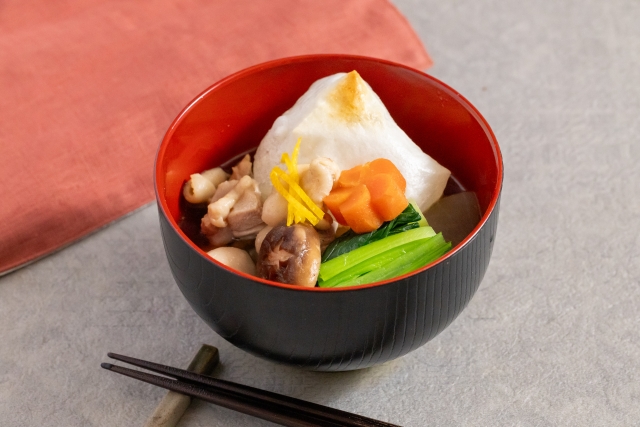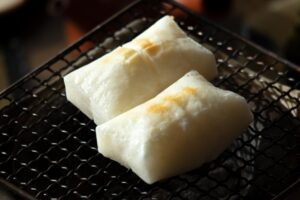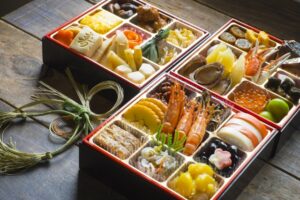Ozoni is a traditional Japanese New Year’s soup dish characterized by its inclusion of mochi (rice cakes). It is often enjoyed alongside Osechi Ryori and is an essential part of the New Year’s feast. The ingredients and seasoning vary by region, reflecting the local food culture.



Characteristics of Ozoni
Ozoni is a warm soup dish made with dashi broth, mochi, vegetables, and meat or fish. The broth can be either a clear soy sauce-based soup or a miso-based soup, depending on the region.
Types of Ozoni
- Clear Broth Zoni (Eastern Japan, Kanto Region): Made with a light soy sauce or salt-based broth, served with grilled mochi.
- Miso Zoni (Western Japan, Kansai Region): Uses white or red miso broth with round mochi.
- Chicken Zoni (Kyushu, Tohoku, etc.): Features chicken for a rich, flavorful broth.
- Seafood Zoni (Setouchi, Hokuriku, etc.): Includes seafood like sea bream, shrimp, or crab.
- Sweet Red Bean Zoni (Shimane, Tottori, etc.): Uses mochi filled with sweet red bean paste in a unique style.
How to Make Ozoni (Basic Example)
- Prepare the Dashi: Make a flavorful broth using kombu or bonito flakes.
- Prepare Ingredients: Cut vegetables, meat, or fish.
- Make the Soup: Season the broth with soy sauce or miso.
- Prepare the Mochi: Grill or boil the rice cakes.
- Assemble: Place mochi and ingredients in a bowl, then pour the soup over.
History of Ozoni
The origins of Ozoni date back to the Muromachi period (14th-16th century), when it was served at samurai banquets. It later spread among the common people and became a staple New Year’s dish, with unique variations developing across Japan.
Nutrition and Health Considerations
Since mochi is the main ingredient, zoni is a good source of energy, but it should be consumed in moderation. Adding vegetables and proteins enhances its nutritional balance.
Cultural Significance of Ozoni
Zoni is considered an auspicious dish that celebrates the beginning of the year. It is traditionally eaten with family, and regional differences, such as grilled vs. round mochi, reflect local customs and traditions.
Common Foods Eaten with Ozoni
- Osechi Ryori (Kuromame, Kazunoko, Tazukuri, Datemaki, Kombumaki, etc.)
- Tsukemono (Pickles) (Takuan, Senmaizuke, etc.)
- White Rice (Some people eat rice even though Zoni already contains mochi.)
- Omiki (Sacred Sake) (A traditional sake consumed during celebrations.)
Comments